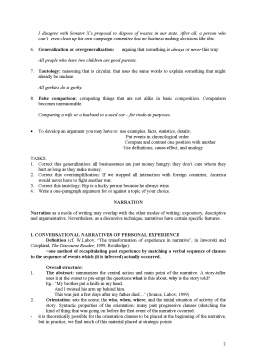Extras din curs
1. DEFINITIONS OF DISCOURSE
1.1. Introduction
In this introductory unit we are going to look at a number of definitions of discourse and to try to define some key terms used in discourse analysis, with the aim of clarifying its scope in such a way that it can deal with a wide range of problems and phenomena, but in a more systematic and coherent way.
Discourse analysis refers, in a very basic sense, to talk. What most people do most of the time is talk, because to do anything requires talk and, often, texts, both in private and public spheres. However, until recently, little attention has been given to what people actually say and do in particular everyday circumstances. People talk about the world, about their work, about others and their relations with them. And in talking, they do things. That was Austin’s (1962) revolutionary insight into an aspect of language that had not been fully recognized: the pragmatic function of language, what language does to make social life possible. This turn to language, or to discourse, has had the effect of breaking down barriers between different social sciences concerned with the analysis of everyday social life.
1.2. Definitions of discourse
Discourse analysis is widely recongnised as one of the most vast and least defined areas of linguistics. One reason for this is that the understanding of discourse is based on scholarship from a number of academic disciplines that are quite different from one another, such as, the philosophy of language, pragmatics, sociolinguistics.
In a very general sense, two definitions are prevalent in the field, which underlie two different assumptions about the general nature of language and the goals of linguistics: the so-called ‘structuralist’ or ‘formalist’ approach, and the so-called ‘functional’ approach. The former defines discourse analysis as ‘language above the level of the sentence’ (Stubbs, 1983, and many others). Those who practise the formalist approach to language analyse discourse to find constituents that have certain relationships with one another and occur in a number of arrangements (the sort of linguistic analysis at the level of phonetics, morphology and syntax). We may call this type of approach to the analysis of language ‘sentence linguistics’, and it will not be included in the scope of our course for reasons to be explained further down.
The latter approach defines discourse analysis as ‘language in use, for communication’ (Cook, 1989). Its view is that analysis of discourse cannot be restricted to the description of linguistic forms independent of the purposes/functions which they are designed to serve.
Another definition is that ‘discourse is utterances’ (D.Schiffrin, 1994). Discourse is seen as ‘above’ the sentence (larger than other units of language). In other words, the utterance (not the sentence) is considered the smallest unit of which discourse is comprised, meaning that discourse arises as a collection of inherently contextualised units of language use. We are looking at the construction of meaning, i.e we are talking about ‘utterance meaning’ and ‘speaker meaning’ (and also about how the hearer interprets the meaning of an utterance).
Examples of this view of language are the Speech act approach (based on the philosophy of language), the Ethnography of communication, and pragmatics (the study of meaning in use). The question that such scholars ask is: What gives stretches of language unity and meaning-
Let’s now look at the differences between ‘sentence linguistics’ and ‘discourse analysis’ from the point of view of the types of data they use when analysing language (cf. Cook, 1989).
Preview document
Conținut arhivă zip
- Analiza Discursului
- 1. Introduction to discourse analysis.doc
- 2. DISCOURSE AND TEXTS.ppt
- 4. SPOKEN DISC VS. WRITTEN DISC..doc
- 5. ARGUMENTATION AND NARRATION.doc
- 6. KNOWLEDGE IN DISCOURSE.ppt
- 7. INTERACTION IN WRITTEN TEXTS.ppt
- Interaction and intertextuality.ppt




























